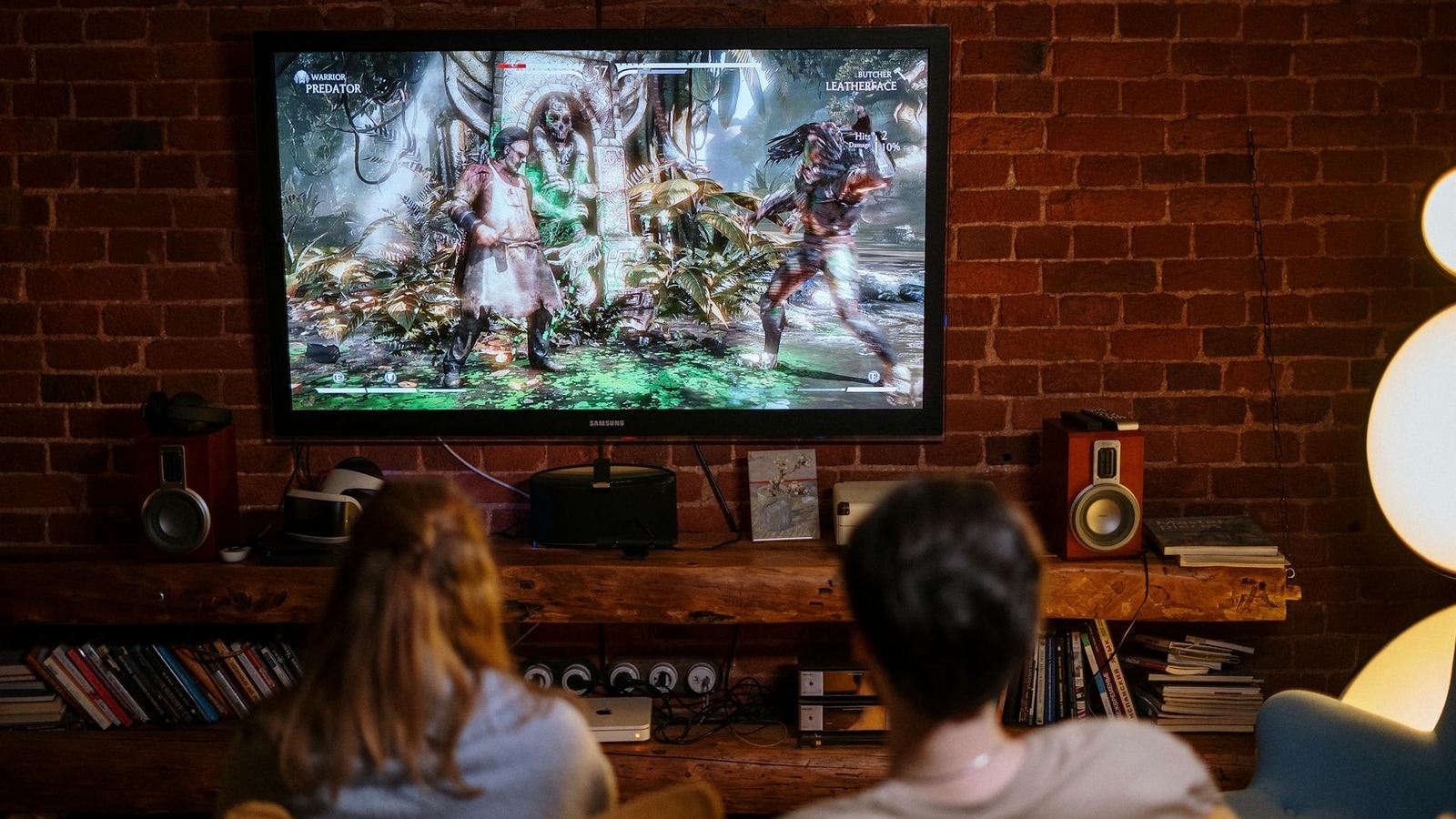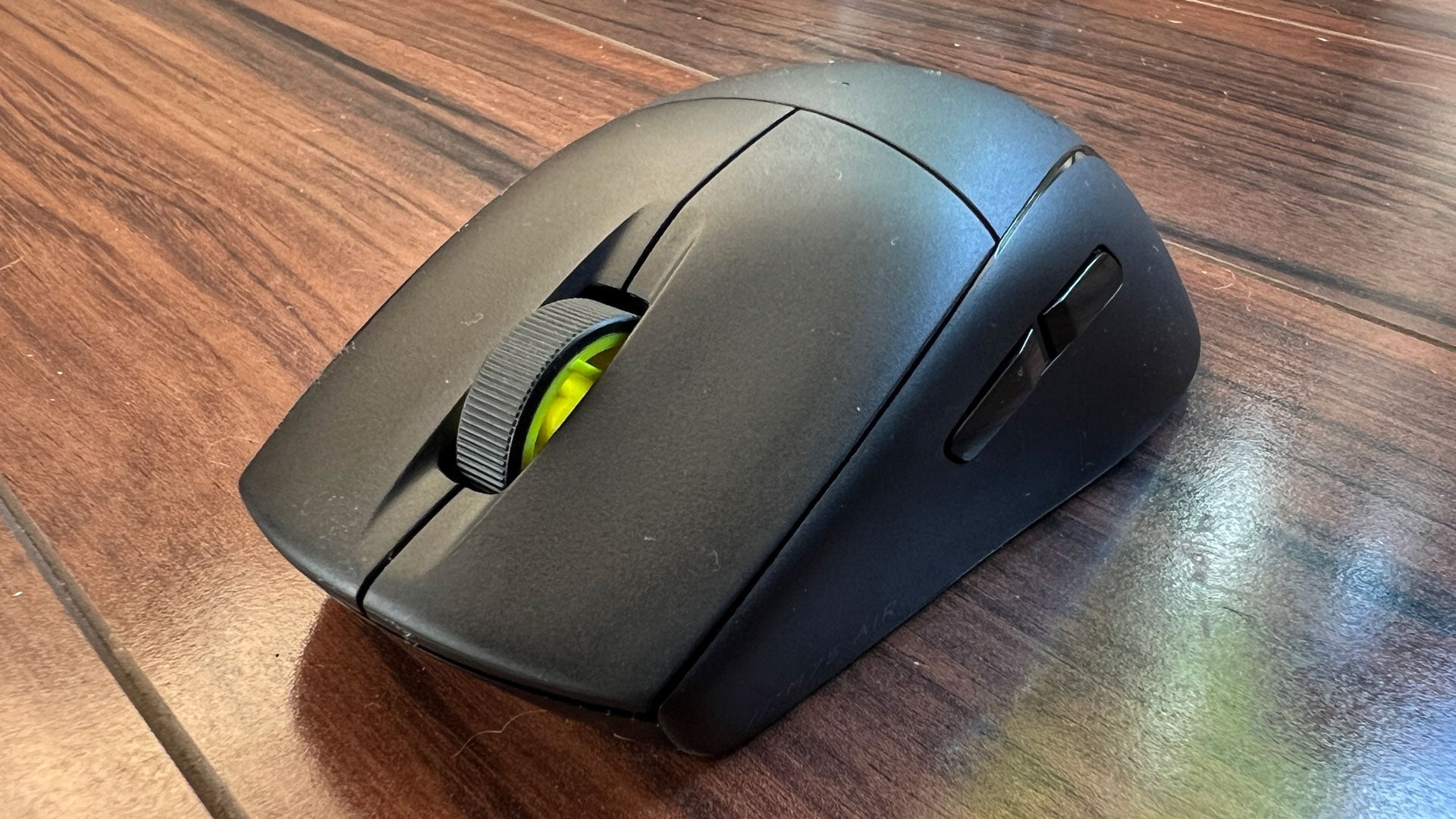Verdict
At just 60g, the Corsair M75 Air is one of the lightest clickers on the market right now. It’s not a standout number at this point, with fierce competition all around, but its accented looks, smooth surface, and great shape pair well with its 2000Hz polling rate to offer a dependable mouse that doesn’t try too hard. It just cuts a few corners for its very high price.
Pros
- 2000Hz wireless and Bluetooth support
- Simple, no-frills shape and style
- Solid battery life
Cons
- No dedicated DPI button
- Right-hand only
- Clunky scroll wheel isn’t for everyone
Introduction
Proving there’s always room for one more, Corsair has finally entered the ultra-lightweight gaming mouse scene.
Somehow missing the dedicated sniper button that put it on the esports map with the M65 all those years ago, the Corsair M75 Air is still a solid clicker with an understated design and few frills.
Continuing to support Bluetooth in the face of cheaper competition, this is a versatile mouse if all you plan to do is rack up killstreaks in countless lobbies. You won’t stand to benefit from its 2000Hz polling chops with it enabled, but portability, easy device switching, and better battery life could very well be enough of a bonus to make it worth its high price.
Next to the value proposition of the otherwise basic Razer Viper V3 Hyperspeed, this could be a tough sell. Instead, it slots more closely into the realm of the more feature-rich Razer Viper V2 Pro and the Logitech G Pro Superlight 2. But what can it do to stand out? After spending a few weeks with the Corsair M75, here are my thoughts.
Design
- Lightly textured black, white, or light grey casing
- Zero RGB for improved battery life
- Rounded chassis and low-profile side buttons
Available in black, white, and light grey, the Corsair M75 Air is clearly gunning for the market Logitech looks to capture with its colourful range of G Pro Superlight clickers. There’s no light blue, pink, or red, but there’s more of an attempt being made here than Razer’s all-black Viper lineup.
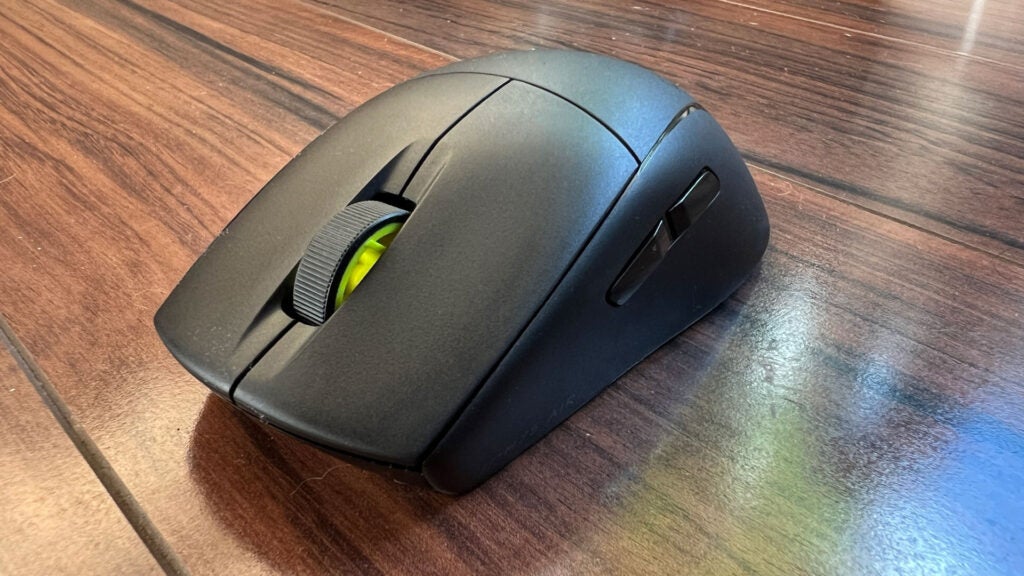
The black version I’ve been testing for the last couple of weeks is the smartest of the lot, with its matte finish often blending into the dimly-lit surroundings of my main gaming space, only slightly reflecting the lighting of my Govee AI Sync Box setup.
Thin and glossy contour trim serves to break up the points between the palm area and the flanks of the mouse, giving the overall package a little more character than Logitech’s more uniform designs – as if there’s inspiration from Roccat’s less angular mice like the Burst Pro Air.
A lot of the more expensive mice aimed at FPS players these days all go for the sleek styling, seemingly to convey professionalism and effort put purely into the fit and feel, and the Corsair M75 Air certainly strikes the right balance between form and function from its outward appearance. One look is enough to know it means business.
The secondary side buttons are slim and set into the case to avoid getting in the way, and the high-arched design isn’t too low or high, which should make it a decent fit for just about anyone. It’s just hard to imagine why it isn’t ambidextrous.
Performance
- Two-stage DPI switching
- 2000Hz polling for swift tracking
- 26,000 DPI ceiling
Using its own Corsair Marksman sensor under the hood, there isn’t a massive amount we can do to test the validity of some of the claims here. 26,000 DPI and 650 IPS is a number that will mean a lot to those who game at higher resolutions and need that intense pixel-pointing accuracy without swinging their arms across a wide tracking area. And for most, it’s far more than necessary.
A lot of the buzzwords are hyperbole at this point. Diminishing returns and a suite of other misunderstood factors like screen resolution, refresh rate, input latency, and a host of others can cloud the data. What’s easy to understand is that throughout testing in my average FPS lobbies highlighted no visible tracking issues – no skipping, hitching, or unresponsiveness.
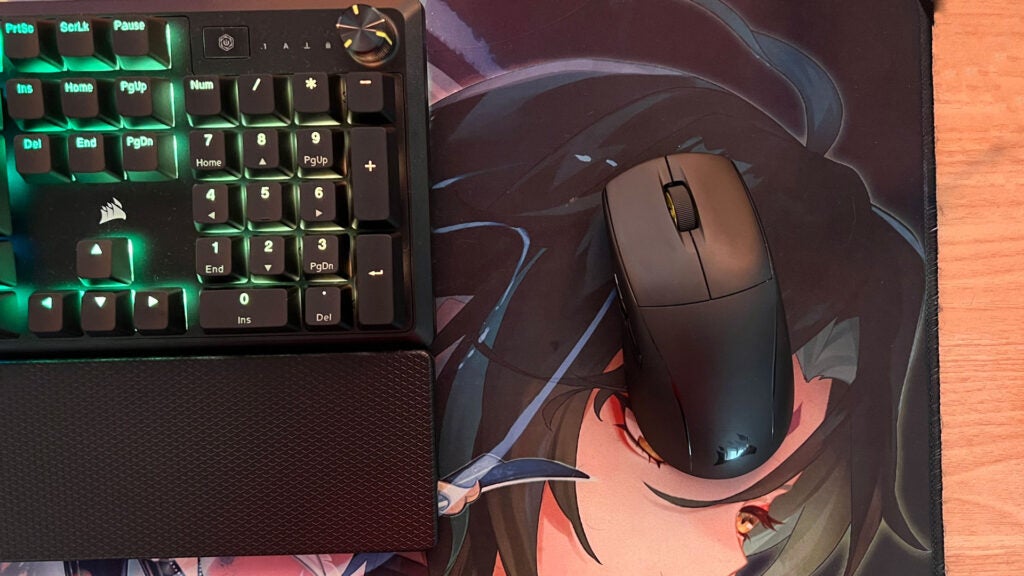
Right from the get-go, I breezed through an unranked Overwatch match after many months away as gruff shooty man Soldier: 76, lost a couple rounds of Halo Infinite, and got some kills in Counter-Strike 2 that even caught me off guard.
Its optical main buttons feel lightning-fast and the side buttons are slim enough to avoid misclicks while still pronounced and responsive enough to rely on. The scroll wheel’s rigidity won’t suit those who favour a smoother scroll, but for weapon switchers, the tactile bump of each stage will be welcome. Next to a mouse that doesn’t quite need the speed, like the Corsair Scimitar Elite Wireless, is a little loud.
It’s been a while since a mouse has had any issues shine through with basic tests like these, but there’s rarely a reason to doubt the most basic functionality on offer with these premium clickers. 2000Hz polling as standard through the included dongle suits my 100Hz LG Ergo monitor just fine, and while it’s far from the 360Hz panels you’ll see wannabe pros picking up for every minor advantage they can get, it’s a good reference point for what to expect.
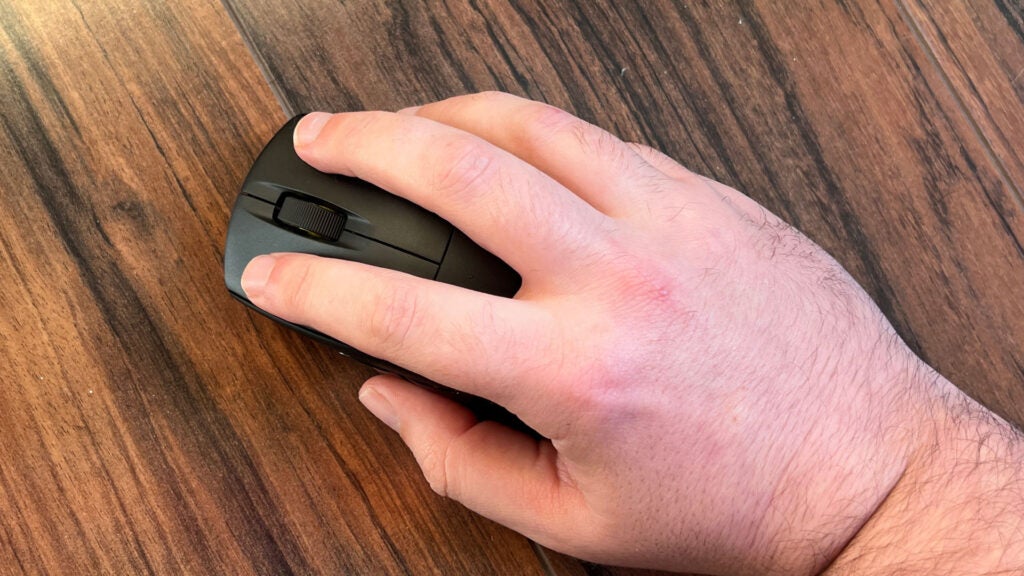
In a wireless mouse designed for frantic team-based online titles, a battery indicator kicking in at the start of a 40-minute round could mean the end of a match before it’s even really begun. The kicker here is that the Corsair M75 Air can manage only 34 hours when sustaining those high specifications. Bluetooth fares much better at around 100 hours, but you’ll lose most of that performance in the process, making the feature only really worthwhile for getting busywork done on a laptop at the cafe.
Next to the Logitech G Pro X Superlight 2 and its 95-hour battery and wireless charging support for only £10 more, it’s a major blow. Even the consistently popular Razer DeathAdder V3 Pro matches this or closes in on the Corsair’s battery life by doubling its effective polling rate to a ridiculous 4,000Hz. Suddenly Corsair’s big numbers lose their magic. Charging via USB-C doesn’t take long, but it’s the principle that counts.
Software and Lighting
- Single on-board profile
- No RGB options
- Battery saving methods
The Corsair M75 Air has little in the way of RGB bells and whistles. That’s likely an intentional effort on Corsair’s part. Despite all the efforts to incorporate flashy visuals into every aspect of our desktop experience over the years, if there’s one thing we can all agree on, it’s that ultimately unnecessary lighting affects battery performance to a humongous degree.
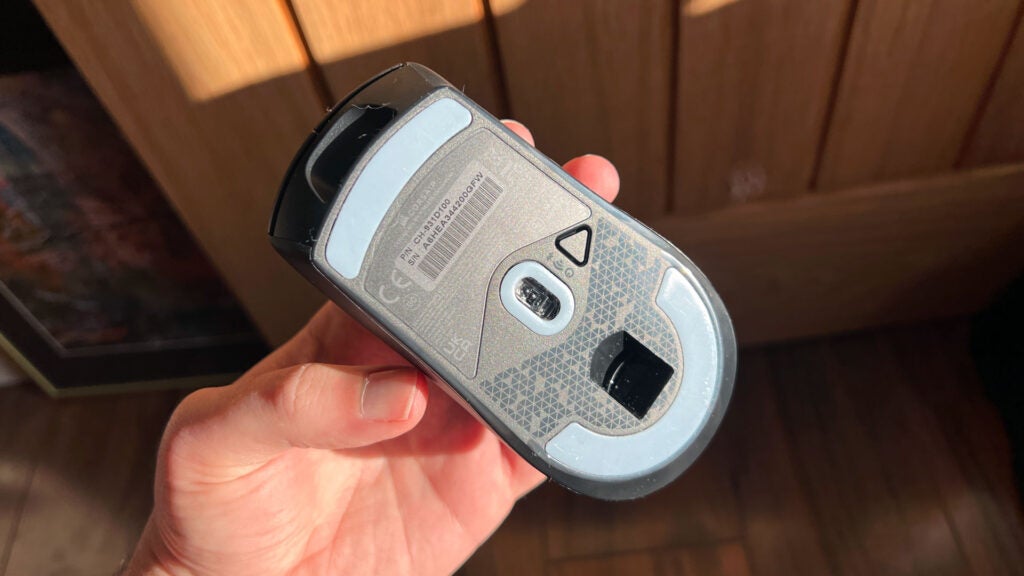
Even still, you’re going to want the iCUE software installed alongside the Corsair M75 Air. It’s not entirely necessary for consistent use because of that aforementioned omission of RGB lighting, but the 1200 DPI default setting, while great for me, won’t suit everyone. With no dedicated DPI switcher on the mouse, it’s the only way to dial in your preferred settings.
Beyond being able to crank this up to 26,000 DPI, you can use the software to reassign each key through virtually unlimited profiles. You can assign one of the side buttons to serve as a popular “Sniper” button to toggle another DPI setting when held, but it’s not enabled by default.
On-device memory is limited to a single profile, so you won’t be able to do much switching whenever iCUE isn’t available (for example, when it’s closed or you’re on a different machine temporarily). That could very well be a dealbreaker for those who bounce between different machines for different purposes.
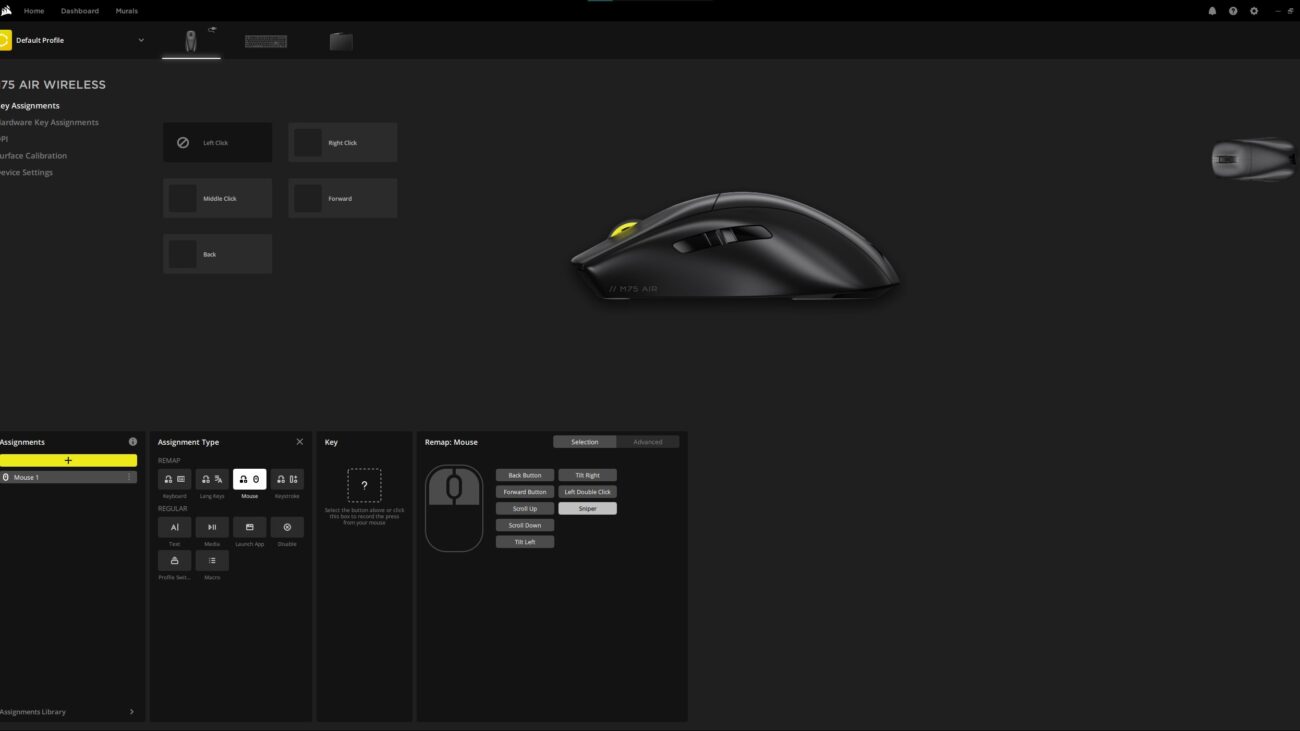
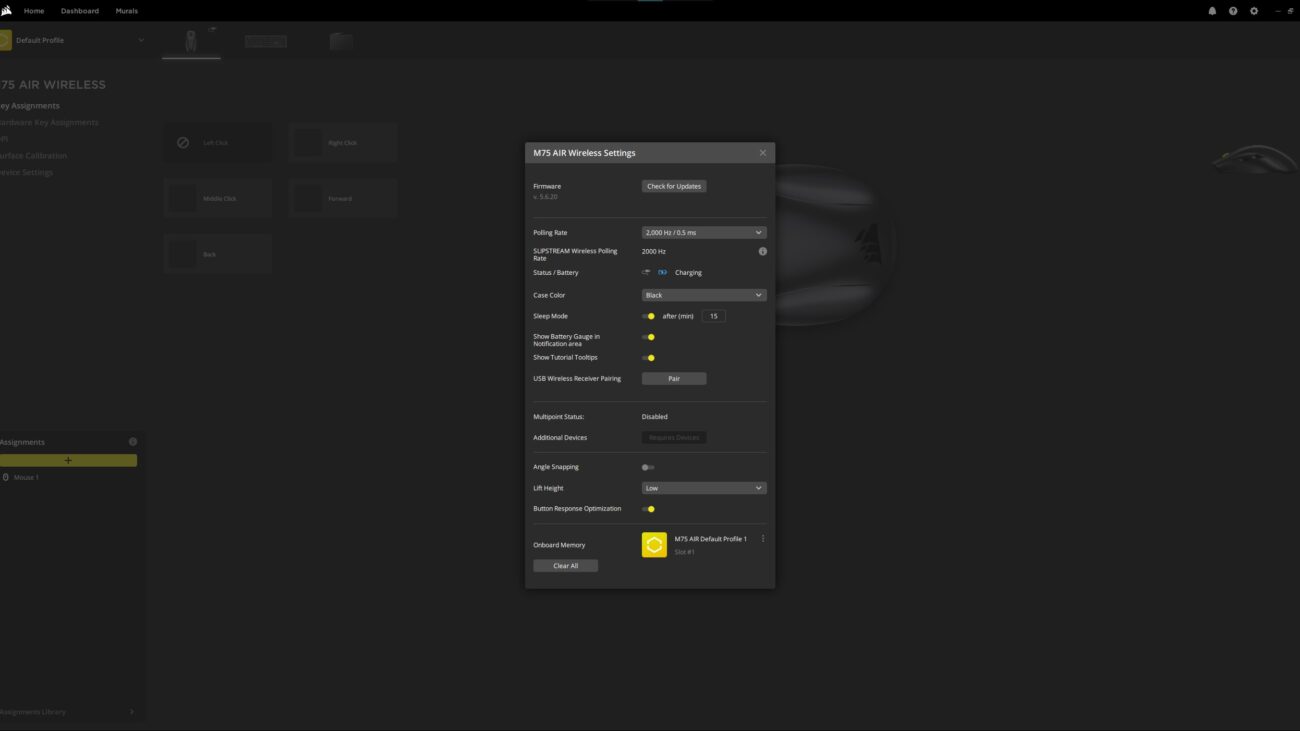
Corsair M75 Air software
Corsair M75 Air software
Thankfully, other settings that are applied on-device rather than controlled via iCue are angle snapping, lift height, and button response optimization. With iCue enabled and working, you can connect the mouse via USB-C to update its firmware and change surface calibration settings, which is great if you’re susceptible to uneven surfaces or sensitive to the subtle differences between two different mouse mats.
There are few tooltips to explain them to those new to high-performance mice, and actually assigning them is rarely clear. In the process of attempting to assign the Sniper command to shift down to a lower DPI when holding the Back button on the side, the software would constantly crash.
Latest deals
Should you buy it?
You want a no-frills gaming mouse from a reputable brand
Unless you need more on-device profiles, nothing will get in your way with the Corsair M75 Air.
You’re not looking to go pro
The Corsair M75 Air really shines at the top end of FPS setups. If you don’t plan on fully upgrading a basic setup, you’ll find more suitable options at a fraction of the price.
Final Thoughts
The Corsair M75 Air is a no-frills gaming goliath, but only under exact circumstances will it shine. It commands a premium price that can cloud the judgement of the average gamer who won’t have the skill or supplementary equipment to make the most of its top-tier internals.
Even at this price, there are some cut corners that may sting. The omission of a dedicated DPI toggle and ambidextrous support is a real shame, while the software experience needs simplifying, too.
If you’re already spending hundreds on each part of your PC gaming setup, there’s a chance you’ll have what you need to notice the difference between a mid-range mouse like the Logitech G305 Lightspeed and the top-end Roccat Kone XP Air.
If not, the Corsair M75 Air isn’t going to be the thing that makes the difference. Unless you’re upgrading from a bargain bin clicker, at which point grabbing something like the Roccat Kone Air will suffice. Check out our Best Gaming Mouse guide for even more options.
How we test
We use every mouse we test for at least a week. During that time, we’ll check it for ease of use and put it through its paces by playing a variety of different genres, including FPS, strategy and MOBAs.
We also check each mouse’s software to see how easy it is to customise and set up.
FAQs
The Corsair M75 Air only weighs 60 grams, making it one of the lightest gaming mice you can buy.
The Corsair M75 Air has a 2000Hz polling rate.
Trusted Reviews test data
Verdict
At just 60g, the Corsair M75 Air is one of the lightest clickers on the market right now. It’s not a standout number at this point, with fierce competition all around, but its accented looks, smooth surface, and great shape pair well with its 2000Hz polling rate to offer a dependable mouse that doesn’t try too hard. It just cuts a few corners for its very high price.
Pros
- 2000Hz wireless and Bluetooth support
- Simple, no-frills shape and style
- Solid battery life
Cons
- No dedicated DPI button
- Right-hand only
- Clunky scroll wheel isn’t for everyone
Introduction
Proving there’s always room for one more, Corsair has finally entered the ultra-lightweight gaming mouse scene.
Somehow missing the dedicated sniper button that put it on the esports map with the M65 all those years ago, the Corsair M75 Air is still a solid clicker with an understated design and few frills.
Continuing to support Bluetooth in the face of cheaper competition, this is a versatile mouse if all you plan to do is rack up killstreaks in countless lobbies. You won’t stand to benefit from its 2000Hz polling chops with it enabled, but portability, easy device switching, and better battery life could very well be enough of a bonus to make it worth its high price.
Next to the value proposition of the otherwise basic Razer Viper V3 Hyperspeed, this could be a tough sell. Instead, it slots more closely into the realm of the more feature-rich Razer Viper V2 Pro and the Logitech G Pro Superlight 2. But what can it do to stand out? After spending a few weeks with the Corsair M75, here are my thoughts.
Design
- Lightly textured black, white, or light grey casing
- Zero RGB for improved battery life
- Rounded chassis and low-profile side buttons
Available in black, white, and light grey, the Corsair M75 Air is clearly gunning for the market Logitech looks to capture with its colourful range of G Pro Superlight clickers. There’s no light blue, pink, or red, but there’s more of an attempt being made here than Razer’s all-black Viper lineup.

The black version I’ve been testing for the last couple of weeks is the smartest of the lot, with its matte finish often blending into the dimly-lit surroundings of my main gaming space, only slightly reflecting the lighting of my Govee AI Sync Box setup.
Thin and glossy contour trim serves to break up the points between the palm area and the flanks of the mouse, giving the overall package a little more character than Logitech’s more uniform designs – as if there’s inspiration from Roccat’s less angular mice like the Burst Pro Air.
A lot of the more expensive mice aimed at FPS players these days all go for the sleek styling, seemingly to convey professionalism and effort put purely into the fit and feel, and the Corsair M75 Air certainly strikes the right balance between form and function from its outward appearance. One look is enough to know it means business.
The secondary side buttons are slim and set into the case to avoid getting in the way, and the high-arched design isn’t too low or high, which should make it a decent fit for just about anyone. It’s just hard to imagine why it isn’t ambidextrous.
Performance
- Two-stage DPI switching
- 2000Hz polling for swift tracking
- 26,000 DPI ceiling
Using its own Corsair Marksman sensor under the hood, there isn’t a massive amount we can do to test the validity of some of the claims here. 26,000 DPI and 650 IPS is a number that will mean a lot to those who game at higher resolutions and need that intense pixel-pointing accuracy without swinging their arms across a wide tracking area. And for most, it’s far more than necessary.
A lot of the buzzwords are hyperbole at this point. Diminishing returns and a suite of other misunderstood factors like screen resolution, refresh rate, input latency, and a host of others can cloud the data. What’s easy to understand is that throughout testing in my average FPS lobbies highlighted no visible tracking issues – no skipping, hitching, or unresponsiveness.

Right from the get-go, I breezed through an unranked Overwatch match after many months away as gruff shooty man Soldier: 76, lost a couple rounds of Halo Infinite, and got some kills in Counter-Strike 2 that even caught me off guard.
Its optical main buttons feel lightning-fast and the side buttons are slim enough to avoid misclicks while still pronounced and responsive enough to rely on. The scroll wheel’s rigidity won’t suit those who favour a smoother scroll, but for weapon switchers, the tactile bump of each stage will be welcome. Next to a mouse that doesn’t quite need the speed, like the Corsair Scimitar Elite Wireless, is a little loud.
It’s been a while since a mouse has had any issues shine through with basic tests like these, but there’s rarely a reason to doubt the most basic functionality on offer with these premium clickers. 2000Hz polling as standard through the included dongle suits my 100Hz LG Ergo monitor just fine, and while it’s far from the 360Hz panels you’ll see wannabe pros picking up for every minor advantage they can get, it’s a good reference point for what to expect.

In a wireless mouse designed for frantic team-based online titles, a battery indicator kicking in at the start of a 40-minute round could mean the end of a match before it’s even really begun. The kicker here is that the Corsair M75 Air can manage only 34 hours when sustaining those high specifications. Bluetooth fares much better at around 100 hours, but you’ll lose most of that performance in the process, making the feature only really worthwhile for getting busywork done on a laptop at the cafe.
Next to the Logitech G Pro X Superlight 2 and its 95-hour battery and wireless charging support for only £10 more, it’s a major blow. Even the consistently popular Razer DeathAdder V3 Pro matches this or closes in on the Corsair’s battery life by doubling its effective polling rate to a ridiculous 4,000Hz. Suddenly Corsair’s big numbers lose their magic. Charging via USB-C doesn’t take long, but it’s the principle that counts.
Software and Lighting
- Single on-board profile
- No RGB options
- Battery saving methods
The Corsair M75 Air has little in the way of RGB bells and whistles. That’s likely an intentional effort on Corsair’s part. Despite all the efforts to incorporate flashy visuals into every aspect of our desktop experience over the years, if there’s one thing we can all agree on, it’s that ultimately unnecessary lighting affects battery performance to a humongous degree.

Even still, you’re going to want the iCUE software installed alongside the Corsair M75 Air. It’s not entirely necessary for consistent use because of that aforementioned omission of RGB lighting, but the 1200 DPI default setting, while great for me, won’t suit everyone. With no dedicated DPI switcher on the mouse, it’s the only way to dial in your preferred settings.
Beyond being able to crank this up to 26,000 DPI, you can use the software to reassign each key through virtually unlimited profiles. You can assign one of the side buttons to serve as a popular “Sniper” button to toggle another DPI setting when held, but it’s not enabled by default.
On-device memory is limited to a single profile, so you won’t be able to do much switching whenever iCUE isn’t available (for example, when it’s closed or you’re on a different machine temporarily). That could very well be a dealbreaker for those who bounce between different machines for different purposes.


Corsair M75 Air software
Corsair M75 Air software
Thankfully, other settings that are applied on-device rather than controlled via iCue are angle snapping, lift height, and button response optimization. With iCue enabled and working, you can connect the mouse via USB-C to update its firmware and change surface calibration settings, which is great if you’re susceptible to uneven surfaces or sensitive to the subtle differences between two different mouse mats.
There are few tooltips to explain them to those new to high-performance mice, and actually assigning them is rarely clear. In the process of attempting to assign the Sniper command to shift down to a lower DPI when holding the Back button on the side, the software would constantly crash.
Latest deals
Should you buy it?
You want a no-frills gaming mouse from a reputable brand
Unless you need more on-device profiles, nothing will get in your way with the Corsair M75 Air.
You’re not looking to go pro
The Corsair M75 Air really shines at the top end of FPS setups. If you don’t plan on fully upgrading a basic setup, you’ll find more suitable options at a fraction of the price.
Final Thoughts
The Corsair M75 Air is a no-frills gaming goliath, but only under exact circumstances will it shine. It commands a premium price that can cloud the judgement of the average gamer who won’t have the skill or supplementary equipment to make the most of its top-tier internals.
Even at this price, there are some cut corners that may sting. The omission of a dedicated DPI toggle and ambidextrous support is a real shame, while the software experience needs simplifying, too.
If you’re already spending hundreds on each part of your PC gaming setup, there’s a chance you’ll have what you need to notice the difference between a mid-range mouse like the Logitech G305 Lightspeed and the top-end Roccat Kone XP Air.
If not, the Corsair M75 Air isn’t going to be the thing that makes the difference. Unless you’re upgrading from a bargain bin clicker, at which point grabbing something like the Roccat Kone Air will suffice. Check out our Best Gaming Mouse guide for even more options.
How we test
We use every mouse we test for at least a week. During that time, we’ll check it for ease of use and put it through its paces by playing a variety of different genres, including FPS, strategy and MOBAs.
We also check each mouse’s software to see how easy it is to customise and set up.
FAQs
The Corsair M75 Air only weighs 60 grams, making it one of the lightest gaming mice you can buy.
The Corsair M75 Air has a 2000Hz polling rate.


